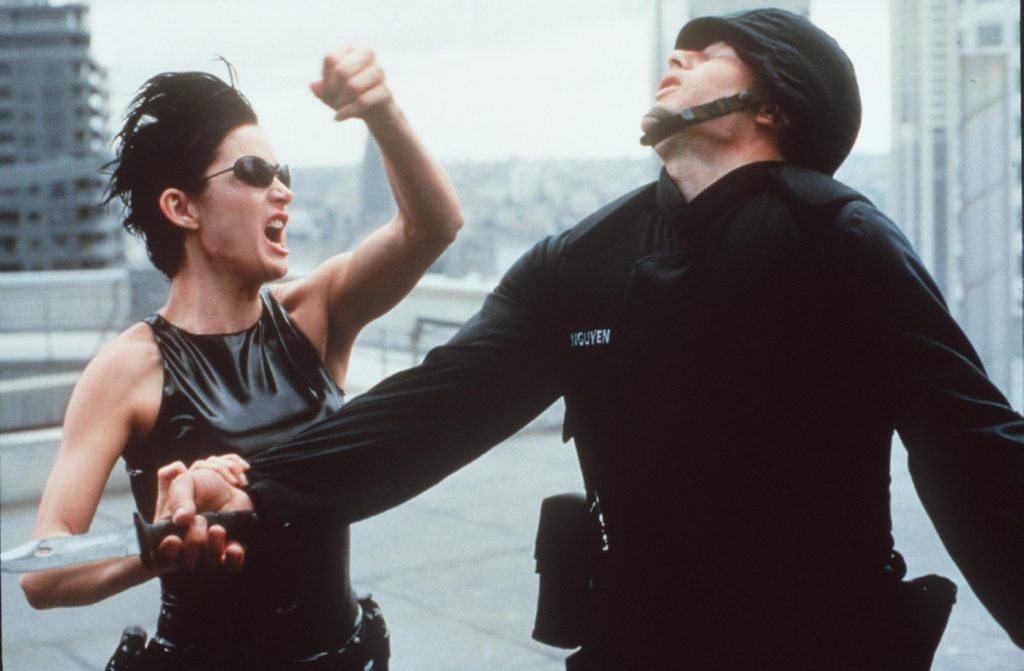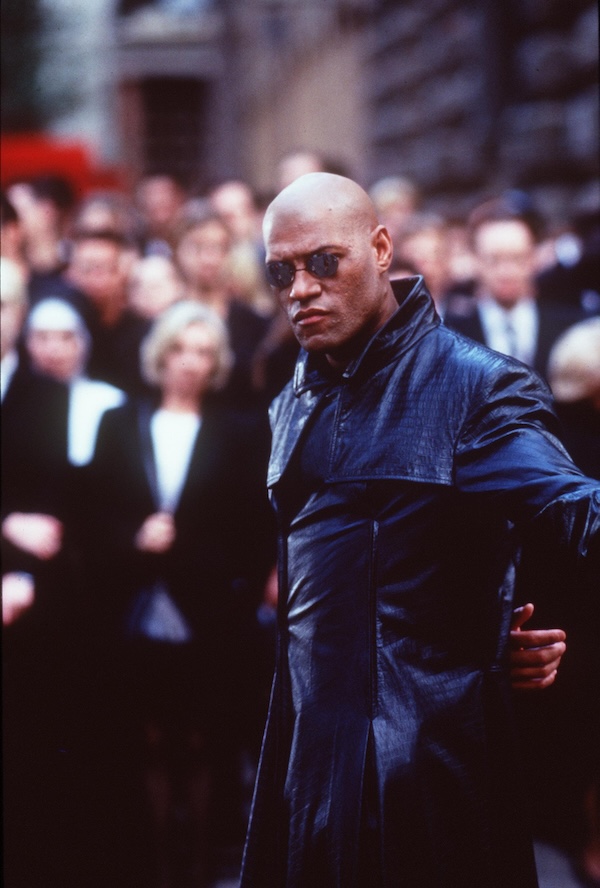A Quarter-Century Later, We’re Quoting “The Matrix” More Than Ever
Wake up, Neo. The Matrix was released 25 years ago this year. From that first entreaty, as it appeared on computer programmer Thomas Anderson’s (Keanu Reeves) black computer screen, to the hacker’s life-changing choice — red pill or blue? — Lilly and Lana Wachowski’s dystopian action thriller became and remains a technological and cultural bellwether.
Hollywood, movie-going, fashion, and superheroes look nothing like they did in 1999, yet The Matrix memes don’t stop, even if they sometimes have little to do with the original material. After a quarter-century of seeding pop culture with ideas we still use today, the movie is a next-generation Star Wars. Even the movie’s themes cribbed from other sources eclipsed their original material. “Follow the white rabbit,” Neo’s computer screen tells him, setting in motion his departure from the Matrix. The command, which opens up the idea of another possible and previously unimagined reality, comes from Lewis Carroll’s Alice in Wonderland but is now just as indelibly part of the Wachowskis’ deeply thought-out Matrix mythology.
Sought out by Morpheus (Laurence Fishburne) to join his rebel crew outside the Matrix, a simulated reality created by intelligent machines enslaving an unaware humanity, Neo proves an unusually adept student as he learns to fight, leap between buildings, and bend spoons with his mind, with the goal of breaking the Matrix and freeing humankind from the machines.
Morpheus is convinced Neo is The One who will achieve this, though the Oracle (Gloria Foster) says otherwise. In their efforts, the rebels cross back and forth into the Matrix via telephone, taking on Agents inside and Sentinels outside. But there’s a mole — crew member Cypher (Joe Pantoliano) regrets choosing the red pill and makes a deal with the Agents to get plugged back into a posh life within the Matrix in exchange for ratting out his comrades. Primary Agent Smith (Hugo Weaving) captures Morpheus and ambushes and seemingly kills Neo during the rescue mission. But when co-leader Trinity (Carrie-Anne Moss) reveals to Neo she’s in love with him, Neo revives, newly able to control the Matrix, defeating Smith and the other Agents.

Key ideas from the story are now idiomatic. Is there “a glitch in the matrix,” i.e., are you seeing or experiencing a minor but unexplained occurrence? That Matrix is the reference point for the oddity in your matrix. Less likely to come up in daily life but just as seeded into contemporary culture is so-called “red-pilling,” a politically right-wing concept that leaving behind reality by buying into various conspiracy theories actually means entering reality. A more jovial coinage, Neo’s realization, “I know kung fu,” has been a persistently-beloved bit of spoof material over the past 25 years. And significantly more broadly, Lilly Wachowski also explained in a 2020 Netflix interview that the transformations we see in the film are an allegory for the trans experience.
The film’s lingo entered the lexicon, and costume designer Kym Barrett’s aesthetic became part of the fashion canon. Years down the line, any black leather-clad celeb hiding behind angular black sunglasses is still pinned as looking Matrix-esque, because not only did Barrett’s work for the film become synonymous with this particular aesthetic, it also helped propagate it. Christian Dior’s Fall 1999 couture collection was inspired by the movie, and the look continues to pop up as a reference point for other designers.

And of course, there’s bullet time, the frozen moment effect during which the camera pans around the protagonists during action scenes. Visual effects supervisor John Gaeta worked with the University of Southern California’s Institute for Creative Technologies to be able to pan a full 360 degrees, while the Wachowskis worked with fellow director and martial arts choreographer Woo-Ping Yuen to design the movie’s reality-bending action scenes. Set against a cyberpunk background, combining different martial arts, and relying on new visual effects techniques to create Neo’s now-iconic bullet-evading backbends, The Matrix’s action sequences have been both earnestly adapted and parodied throughout film and television. Even The Simpsons spoofed the film’s bullet time effects during one of the show’s couch gag intros.
The Wachowskis’ nearly airtight direction wasn’t just thematically and visually groundbreaking, it also made for satisfying movie-going. The Matrix made $463.5 million in theaters, was the fifth-highest earning movie of the year, and inspired three sequels. The Matrix is headed back to theaters on September 19 and 22 to celebrate its 25th anniversary—the Fathom Events has partnered with Insignis Pictures and Warner Bros. on screenings, which will include a special featurette with Jessica Henwick (Bugs) reflecting on the film’s massive cultural impact. A fifth movie in the franchise is now on the way, about which little has been revealed. But with The Martian writer Drew Goddard directing and Lana Wachowski on board as an executive producer, we’re looking forward to seeing how the next installment breaks new ground a quarter-century later.
Featured image: Carrie-Anne, Moss Laurence Fishburne, and Keanu Reeves standing against brick wall in a scene from the film ‘The Matrix Reloaded’, 2003. (Photo by Warner Brothers/Getty Images)



